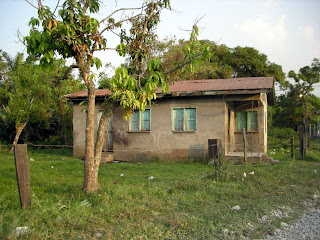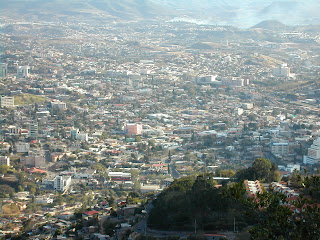Back in the 1950's, the Parque (central park) and the Hotel Paris were the gathering places for all people of La Ceiba. The large shade trees and several benches offered relief from direct sun and an opportunity to greet friends and chat. Across the street, the Hotel with its bar and restaurant attracted a somewhat more affluent crowd. Businessmen and town officials all showed up, sooner or later. Inside, the room was dominated by a massive mahogany bar. Ceiling fans rotated slowly.
Flies were everywhere, and were barely held in check by a half dozen streamers of 'fly paper'. The paper streamers were coated with a very sticky and pungent substance. Once an insect landed, it was stuck fast and soon died. Well, after a few days, one can imagine what these streamers looked like. When the flypaper filled up, it was replaced with a fresh streamer.
I had lunch there a few times, but always felt out of place as the only gringo. Lots of stares and whispering, or so I thought. The bartender didn't seem to care much if a customer was of legal age (whatever it was). Anyone who could reach up and put money on the bartop got beer. There may have been others, but Salva Vida was the choice of most.
The beer wasn't the only attraction for me. Two of the locals rode motorcycles. Now, there was something to get excited about. One was a two-stroke Jawa 250, and the other a BSA 650 "Golden Flash". The BSA was always immaculately clean, in spite of dusty roads. The chrome tank, fenders, and head pipes could blind a fellow in the sunshine. I got close enough to see my reflection−and thus began a lifelong love affair with all things motorcycle.
Most people got about on foot. More often than not, on sandals fashioned from old automobile tire treads. The 'middle class" rode bicycles. The predominate make was the British made Raleigh. Occasionally, one saw a French Peugeot. The 'wealthy' rode motorcycles and scooters. Very few locals owned cars, and most of them were used as taxis.
The cost and having to deal with all the paperwork involved in buying a car Stateside left few choices. Those choices were cars brought into Honduras by Standard Fruit employees and later sold when they left. Our family sold the Nash locally, for more than it had cost in the US.
It was surprising to see a large number of the not so well to do Hondurans traveling by air. The were two airlines that serviced the local airport. TACA and SAHSA. The terminal was barely more than a tin roofed unpainted wooden shack. One paid the fare, and walked out to the plane carrying ones own luggage. The planes were DC 3s, old even then. Seating was two by two fore and aft, with a cargo area just behind the pilot. One could ship just about anything by air. The only limitation was if it wouldn't fit past the cargo door. Once, I flew with crates of chickens and two goats. The cargo area and the passenger area were the same with no partition.
At the time, Tegucigalpa was the only capital city in the world that couldn't be reached by rail. Might explain all the air travel. Trains had always been a passion of mine, and to this day, still are.
La Ceiba, being the shipping port for bananas and mahogany, the were many, many trains coming and going. The train yards were located in Mazapan, so there was alot of activity to interest this 14 year old. The engines were oil fired and steam driven. The larger engines were assigned names of the provinces of Honduras. For example: Atlantida, Yoro, and Santa Barbara. The names were painted in white on the cab's sides. Smaller engines were given the names of towns and villages. Tela, La Lima, Olanchito.
My next door neighbor (Charlie Cate) was the man in charge of railroad operations. After much pleading form me, he got me a job as a mozo (boy) in the yard. My duties were to check the oil levels in the boxcar wheel journal (bearing) boxes with a long spouted oil can and a flashlight. Loss of lubricating oil on the bearings resulted in overheating, destruction of the bearing, and often fires. So all in all, it was a pretty important job for a kid.
For a week's work, I was paid nine lempiras ($4.50 US). This lasted for about a month, and I was fired. Seems someone complained about a 'rich' gringo taking a job away from a needy local to Mr. Cate, and I was out. I can't argue with the logic. My stepfather thought it was the Communist reformers who were always at odds with the banana companies. I always wondered how that looked on my resume: "Fired at fourteen, from first job."
Thank you for the story, Ed. You can read Ed's previous guest blog here.
Hotel Paris is still a popular hotel among gringos today and el Parque Central is still crowded with people all the time. The railroads were eventually turned over to the Honduran government where they were run into the ground and are no longer operational. The remnants of the rails are still being sacked and pilfered for scrap metal. Some of the old rail cars and an engine are on display at Parque Swinford.









































 Welcome to my Blogicito —
Welcome to my Blogicito — 








